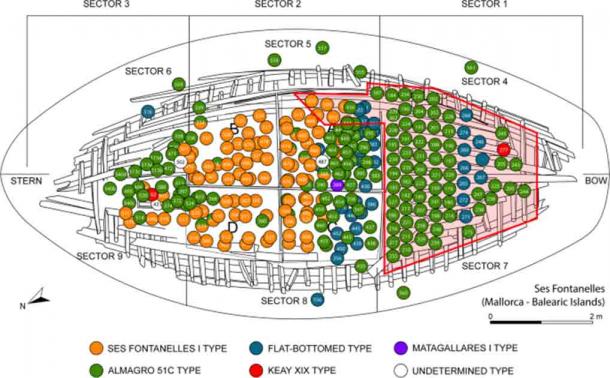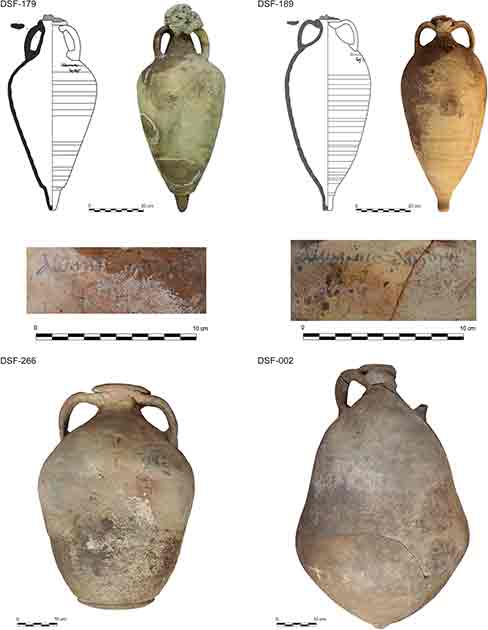Roman Shipwreck Reveals Entirely New Type of Amphora
Archaeologists excavating the hold of a Roman cargo ship off the coast of Mallorca have turned up something new. An entirely unknown type of amphora has been found inside the wreck, which is believed to have a specific design for a specific purpose.
The ship, known as the shipwreck of Ses Fontanelles, lies 220 feet (65 meters) off a popular beach near Palma, the capital of Mallorca. This new type of amphora is one of four different types identified in the packed hold of the cargo ship, reports Heritage Daily.
A Larger Amphora for Plant Oil
According to a paper published in the journal Archaeological and Anthropological Sciences, the ship had been travelling from Cartagena in south east of Spain. It had been carrying a cargo of mixed goods in several different types of amphora when it went down in the Mediterranean some time in the 4th century.
- Ancient Treasures Discovered in Roman Shipwreck at Kasos
- Hundreds of Roman Wine Amphorae Found in Underwater Cave

Diagram of the Roman shipwreck with its cargo. The yellow dots are the new type of amphora (Cau-Ontiveros, M.A., Bernal-Casasola, D., Pecci, A. et al / Archaeological and Anthropological Sciences)
An earlier 2022 study, also published in the journal of Archaeological and Anthropological Studies, had confirmed that there were multiple types of amphorae on board, including large “globular” amphorae located amidships. But it is only now that we know for sure that the cargo does indeed include something entirely new.
The amphora found in the hold have been subdivided into four groups, three of which are previously known. The most common are what is known as Almagro 51c type and, according to the tituli picti on the outside of the amphorae these were carrying anchovy sauce.
Tituli picti are Roman labels painted on the outside of the amphora to allow for easy identification. These are extremely beneficial to the archaeologist as they contain information on the contents, their source, destination, and even the owner. In this case the owner of the contents has been identified as “Alunnius et Ausonius”.
- Illegal Roman Shipwreck Artifacts Found in a Spanish Fish Shop
- Russian scientists use a mass spectrometer to look inside an ancient Greek amphora

The four types of Roman amphora found in the shipwreck. The bottom-right DSF-002 type is the entirely new design (Cau-Ontiveros, M.A., Bernal-Casasola, D., Pecci, A. et al / Archaeological and Anthropological Sciences)
Other amphorae in the hold have been identified as a flat-bottomed type containing fruits, another design known as the Keay XIX type, and an entirely new form of amphora named Ses Fontanelles I after the shipwreck.
This new design is considerably larger and heavier than the other types. It was used for bulk transportation of plant oil.
“All the analytical data suggest that Alunnius et Ausonius prepared a trade enterprise fleeting, a merchant ship with a cargo composed mainly of fish sauce (Liquaminis flos), in Almagro 51c amphora, oil transported in Ses Fontanelles I amphorae (probably an imitation of Dressel 23 type), and grape derivates or fruits preserved in those substances in flat-bottomed amphorae” note the authors of the study.
The archaeologists also note that grape leaves had been used as a padding material known as “dunnage”. They were tightly packed together to protect the delicate amphorae during shipping.
Top Image: The tightly packed amphorae of the Ses Fontanelles Roman shipwreck. Source: Sebastia Munar Llabres, Jaume Cardell, Carlos de Juan, Miguel Angel Cau, Dario Bernal-Casasola, Llorenç Picornell & Enrique Garcia Riaza / Archaeological and Anthropological Sciences.
By Joseph Green
















